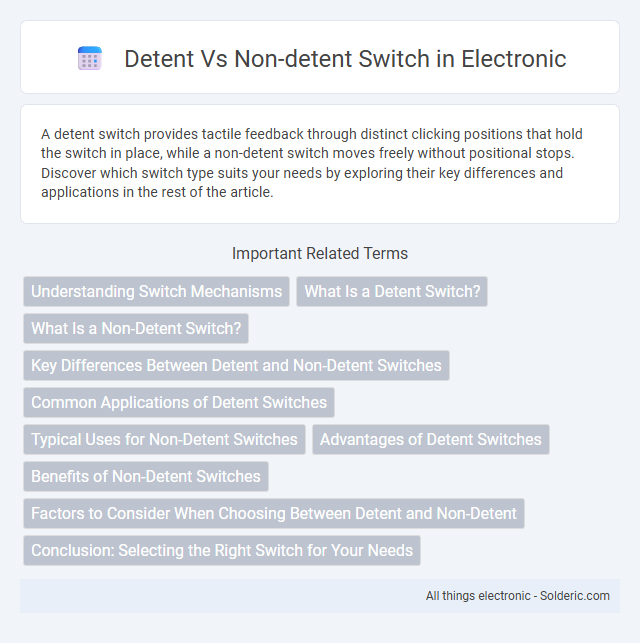A detent switch provides tactile feedback through distinct clicking positions that hold the switch in place, while a non-detent switch moves freely without positional stops. Discover which switch type suits your needs by exploring their key differences and applications in the rest of the article.
Comparison Table
| Feature | Detent Switch | Non-Detent Switch |
|---|---|---|
| Definition | Switch with defined positions held by mechanical detents. | Switch without fixed positions; returns to a neutral or default state. |
| Position Feedback | Provides tactile feedback with snapping clicks at positions. | No tactile feedback; smooth or spring-loaded motion. |
| Applications | Used where position retention is critical, e.g., selectors on audio equipment. | Used for momentary actions, e.g., push buttons and reset switches. |
| Operation | Maintains chosen setting until moved again. | Returns to original state after release. |
| Common Types | Rotary, toggle switches with detent mechanism. | Momentary push-buttons, spring-return toggles. |
| Examples | Volume control knobs, rotary selectors. | Doorbell buttons, keyboard keys. |
Understanding Switch Mechanisms
Detent switches provide tactile feedback by incorporating a mechanical catch or notch that holds the switch in predefined positions, enhancing precision in applications like rotary encoders and volume controls. Non-detent switches lack this mechanical resistance, allowing smooth, continuous movement without distinct stopping points, ideal for applications requiring fluid adjustments. Understanding these mechanisms is essential for selecting the right switch type based on user interface requirements and control accuracy.
What Is a Detent Switch?
A detent switch features a mechanical mechanism that provides tactile feedback by locking the switch into predefined positions, enhancing user control and precision. Unlike non-detent switches, which move freely without distinct stopping points, detent switches offer a noticeable "click" or resistance at each position, making them ideal for applications requiring incremental adjustments. This design improves accuracy in settings such as volume controls, rotary encoders, and various industrial equipment.
What Is a Non-Detent Switch?
A non-detent switch is a type of switch that returns to its default or neutral position immediately after being actuated, providing momentary control rather than maintaining its state. Commonly used in applications like push buttons or keyboards, non-detent switches offer quick, tactile feedback without locking in place. Unlike detent switches, which hold positions with noticeable clicks or stops, non-detent switches operate smoothly and reset automatically, ideal for temporary or pulse activations.
Key Differences Between Detent and Non-Detent Switches
Detent switches feature distinct tactile feedback and locked positions, allowing users to feel and maintain set points, making them ideal for applications requiring precise control like volume knobs or rotary encoders. Non-detent switches provide smooth, continuous rotation without fixed positions, often used in applications needing seamless adjustments such as dimmer switches or joystick controls. The primary difference lies in user feedback and positional stability, with detent switches offering mechanical stops and non-detent switches enabling uninterrupted motion.
Common Applications of Detent Switches
Detent switches are commonly used in applications requiring precise tactile feedback and positional control, such as volume knobs on audio equipment, rotary encoders in industrial machinery, and joystick controllers for gaming. Their feelable 'click' at distinct positions enhances user accuracy and control, making them ideal for settings where incremental adjustments are critical. Choosing detent switches for your device ensures reliable, repeatable input recognition in environments demanding fine-tuned operation.
Typical Uses for Non-Detent Switches
Non-detent switches are commonly used in applications requiring momentary or tactile feedback, such as push buttons, keypads, and control panels where temporary activation is essential. These switches return to their original position after being pressed, making them ideal for functions like reset buttons, volume controls, and computer mouse buttons. Your devices benefit from non-detent switches when quick, repeatable user input without maintaining a switch position is necessary.
Advantages of Detent Switches
Detent switches provide tactile feedback through defined positions, enhancing user precision and control, especially in applications requiring multiple stable states. These switches reduce accidental activations by locking into place, improving operational reliability and safety. Your devices benefit from consistent positioning and durability, making detent switches ideal for settings where exact input is critical.
Benefits of Non-Detent Switches
Non-detent switches provide smoother, continuous control without fixed positions, enhancing precision in applications like volume knobs and dimmers. Their ability to return to the start position automatically reduces wear and tear, improving the durability of your device. These switches are ideal when variable input is required rather than discrete, fixed selections.
Factors to Consider When Choosing Between Detent and Non-Detent
When choosing between detent and non-detent switches, consider the required tactile feedback and positional stability; detent switches provide distinct click points and hold positions, ideal for precise control applications. The application's need for momentary versus maintained activation influences the choice, with non-detent switches offering smooth, continuous motion often used in variable-speed or dimming controls. Durability and user experience factors, such as ease of operation and feedback clarity, also play crucial roles in selecting the appropriate switch type for specific electronic or mechanical systems.
Conclusion: Selecting the Right Switch for Your Needs
Detent switches provide tactile feedback and positional stability, making them ideal for applications requiring precise control and user confirmation. Non-detent switches offer smooth operation without distinct positions, suited for continuous adjustments or settings without fixed stops. Choosing the right switch depends on the desired user experience, control precision, and application requirements.
detent vs non-detent switch Infographic

 solderic.com
solderic.com